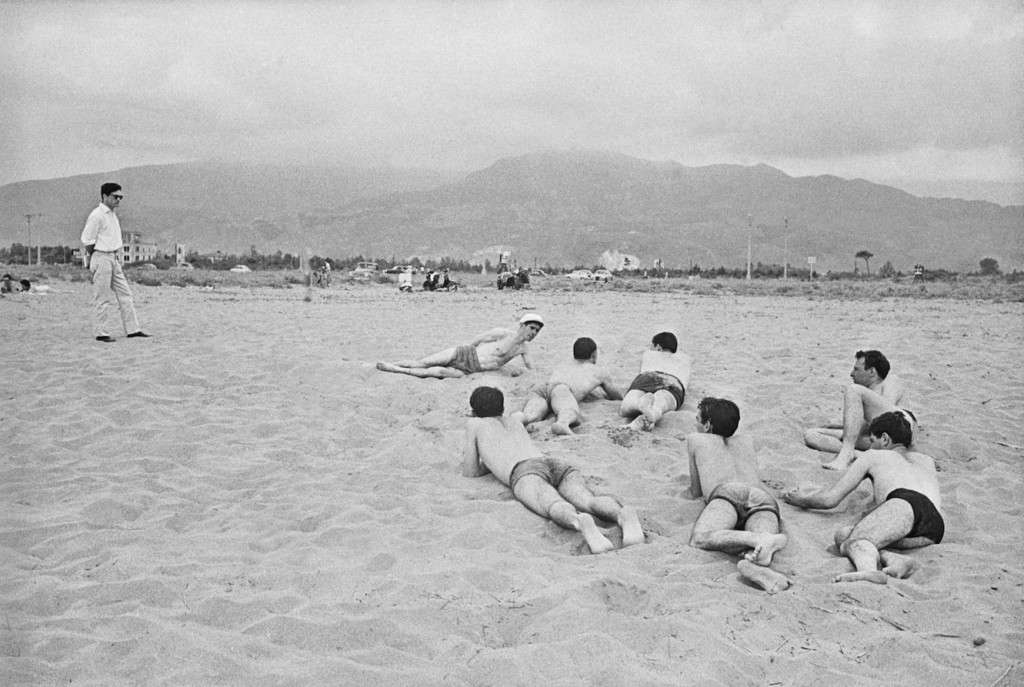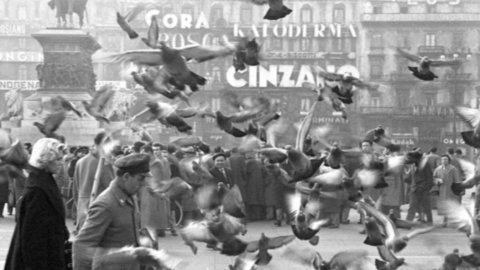The first exhibition, "THE LONG SANDY ROAD"With photographs by Paolo Di Paolo and texts by Pier Paolo Pasolini: one hundred and one images, many of which unpublished, videos and documents. In 1959 Paolo Di Paolo is 34 years old and has been photographing for five years for "Il Mondo" directed by Mario Pannunzio, Pier Paolo Pasolini is a promising 37-year-old writer, he has published The best of youth, Boys of life and A violent life, it is not still director. In Italy the economic miracle has just begun. Italian families tend to be presented in the newspapers with a microcosm of mythical characters, as an alternative to the grayness and fears of war, emigration, poverty to be left behind. Arturo Tofanelli, director of the monthly "Successo" and of the weekly "Tempo", entrusts the report on the summer holidays of Italians to the two authors, who do not know each other.
The writer and the photographer set off together from Ventimiglia, with the plan to travel the coasts of Italy to the south and go up to Trieste. But they have different views. “Pasolini was looking for a lost world, of literary ghosts, an Italy that no longer existed – recalls Di Paolo – I was looking for an Italy that looked to the future. I had also created the title The long sandy road which wanted to indicate the tiring road taken by Italians to achieve well-being and holidays.” A complex, delicate partnership is born, which will unite them only for the first part of the journey, but which will then consolidate in mutual respect and trust.
The long road of sand, the extraordinary picture story by Paolo Di Paolo accompanied by texts by Pier Paolo Pasolini will be published by "Successo" in three episodes (4 July, 14 August and 5 September 1959) and will tell the story of Italians on vacation, from Tyrrhenian to Adriatic;; from Ventimiglia to Ostia;; from Torvaianica to Sicily;; from Santa Maria di Leuca to Trieste.
Pasolini writes: “The mountains of Versilia…laughing or gloomy? Here's one thing you can never understand. A little crazy, in shape, and always inked with end-of-the-world hues, with those pinks, those dry flushes of the marble that leak out as if by chance. But so sweet, legendary. Here is the Cinquale beach. (…)”

The second exhibition, "MILAN (photographs 1956-1962)" is a selection of images by Di Paolo dedicated to the city so loved by the photographer because it is so different from Rome: “It was like going abroad…”. An unprecedented look at a beautiful Milan and its mists.
The homage to the city of Milan continues in the Bulgari space in via Montenapoleone 2 with other unpublished shots on the many poetic "faces" of the city. In addition to the ability to portray moments of everyday life, Paolo Di Paolo's talent has been able to grasp the charisma and beauty of the great actresses of the Dolce Vita who have moved, laughed and dreamed entire Italian generations or those passing through Italy to work to the big Hollywood productions. Chased by the paparazzi, immortalized on social occasions or in moments of private life, actresses love to wear their jewels on and off the set as bright symbols of charm and personal taste.
To enhance the alliance with Bulgari for this project, the Fondazione Sozzani bookstore dedicates a focus to Anna Magnani, Elizabeth Taylor and Gina Lollobrigida, portrayed by Di Paolo with Bulgari jewels during parties and theatrical performances;; also on display are the reproductions of the original sketches of the jewels worn, coming from the Maison's Historical Archive.
Born in 1925 in Larino in Molise, Paolo Di Paolo in 1939 he moved to Rome to achieve the classical high school diploma. Immediately after the war he enrolled in the Faculty of History and Philosophy at La Sapienza University. He frequents the artistic circles of Rome, coming into close contact with the "Forma 1" group. His friends, his artists, encourage him to develop his creative vein through photography. He worked in publishing and in 1953 he was appointed editor-in-chief of the magazine "Viaggi in Italia". He started out as a photographer as an amateur, in the sense of «photographing for pleasure».
In 1954 his first photo was published in the cultural weekly "Il Mondo" in which, until the closure of the newspaper in 1966, Di Paolo was to be the most published photographer. Between 1954 and 1956 he collaborated with "La Settembre Incom Illustrata" and in the same period he began working for the weekly magazine "Tempo". Numerous investigations and services signed with Antonio Cederna, Lamberti Sorrentino, Mino Guerrini, Luigi Romersa. In the early XNUMXs, as a correspondent, he traveled to the Soviet Union, Iran, Japan, the United States, as well as throughout Europe. He documents Pasolini during the filming of the films Mamma Roma with Anna Magnani and of The Gospel according to Matthew.
In 1966 Pannunzio's "Il Mondo" closes, shortly after the direction of "Tempo" also changes, with the advent of television and the paparazzi, information is increasingly oriented towards news and scandalous scoops. He concludes his photographic career by collaborating on the services of Irene Brin, a famous lifestyle journalist, with exclusive reportages on fashion and on the international jet set.
In 1968 Paolo Di Paolo abandoned the camera and retired to the countryside outside Rome. He returns to philosophical studies and historical research. From 1970 to 2015 he curated editorial projects, including the Historical Calendar of the Carabinieri.
The photographic archive, over 250.000 negatives, proofs, prints and slides, will remain hidden, perfectly ordered, for decades. It is found by chance in the early 2000s by his daughter Silvia who discovers an unknown part of her father's life and brings to light the extraordinary reading of an unrepeatable historical moment.
In 2019 the MAXXI museum, the National Museum of XXI Century Arts in Rome, is dedicating the important retrospective "Mondo Perduto" to Paolo Di Paolo. A documentary film on the life of Paolo Di Paolo directed by Bruce Weber is currently in production.
Cover image: Paolo Di Paolo, Rally in Piazza del Duomo, 1958 © Paolo Di Paolo Photographic Archive





